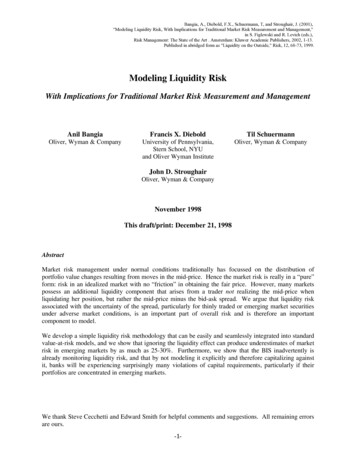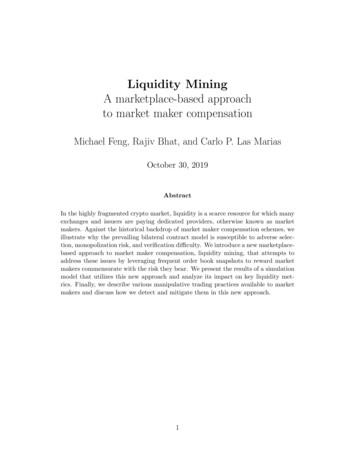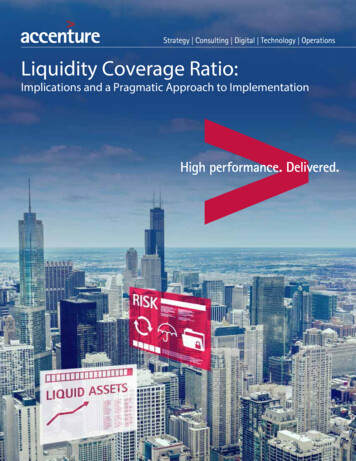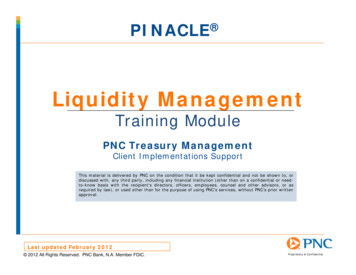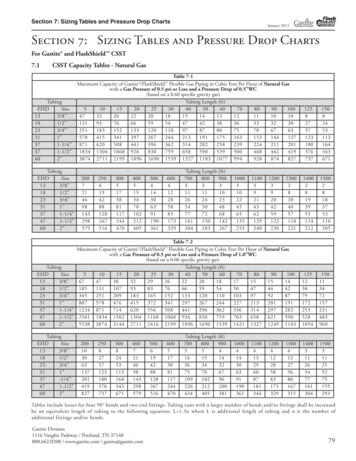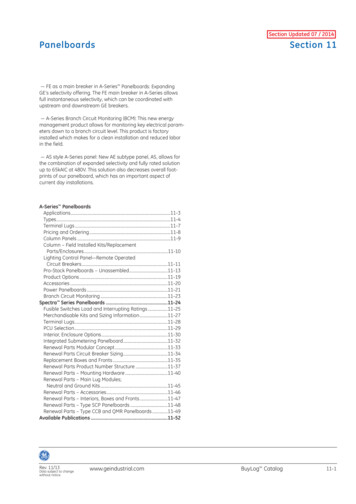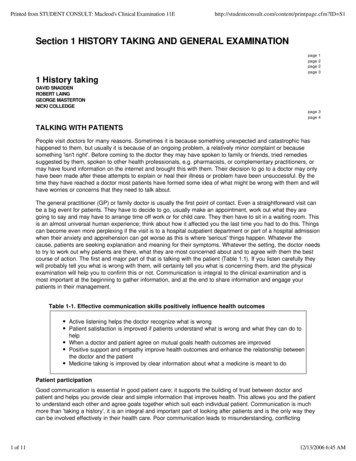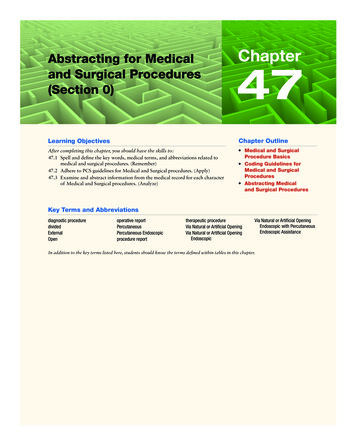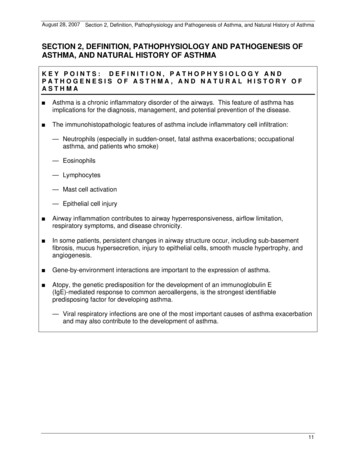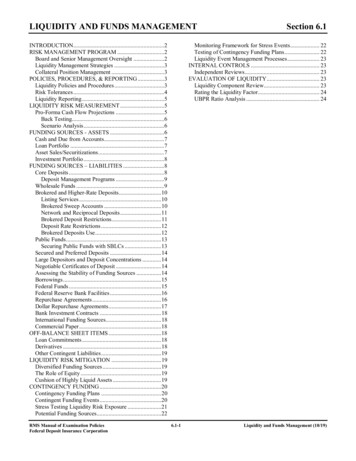
Transcription
LIQUIDITY AND FUNDS MANAGEMENTINTRODUCTION.2RISK MANAGEMENT PROGRAM .2Board and Senior Management Oversight .2Liquidity Management Strategies .3Collateral Position Management .3POLICIES, PROCEDURES, & REPORTING .3Liquidity Policies and Procedures .3Risk Tolerances .4Liquidity Reporting .5LIQUIDITY RISK MEASUREMENT .5Pro-Forma Cash Flow Projections .5Back Testing.6Scenario Analysis .6FUNDING SOURCES - ASSETS .6Cash and Due from Accounts .7Loan Portfolio .7Asset Sales/Securitizations .7Investment Portfolio .8FUNDING SOURCES – LIABILITIES .8Core Deposits .8Deposit Management Programs .9Wholesale Funds .9Brokered and Higher-Rate Deposits. 10Listing Services . 10Brokered Sweep Accounts . 10Network and Reciprocal Deposits . 11Brokered Deposit Restrictions. 11Deposit Rate Restrictions . 12Brokered Deposits Use . 12Public Funds . 13Securing Public Funds with SBLCs . 13Secured and Preferred Deposits . 14Large Depositors and Deposit Concentrations . 14Negotiable Certificates of Deposit . 14Assessing the Stability of Funding Sources . 14Borrowings . 15Federal Funds . 15Federal Reserve Bank Facilities . 16Repurchase Agreements . 16Dollar Repurchase Agreements . 17Bank Investment Contracts . 18International Funding Sources. 18Commercial Paper . 18OFF-BALANCE SHEET ITEMS . 18Loan Commitments . 18Derivatives . 18Other Contingent Liabilities . 19LIQUIDITY RISK MITIGATION . 19Diversified Funding Sources . 19The Role of Equity . 19Cushion of Highly Liquid Assets . 19CONTINGENCY FUNDING . 20Contingency Funding Plans . 20Contingent Funding Events . 20Stress Testing Liquidity Risk Exposure . 21Potential Funding Sources . 22RMS Manual of Examination PoliciesFederal Deposit Insurance CorporationSection 6.1Monitoring Framework for Stress Events . 22Testing of Contingency Funding Plans . 22Liquidity Event Management Processes . 23INTERNAL CONTROLS . 23Independent Reviews . 23EVALUATION OF LIQUIDITY . 23Liquidity Component Review. 23Rating the Liquidity Factor . 24UBPR Ratio Analysis . 246.1-1Liquidity and Funds Management (10/19)
LIQUIDITY AND FUNDS MANAGEMENT INTRODUCTION Liquidity reflects a financial institution’s ability to fundassets and meet financial obligations. Liquidity is essentialin all banks to meet customer withdrawals, compensate forbalance sheet fluctuations, and provide funds for growth.Funds management involves estimating liquidityrequirements and meeting those needs in a cost-effectiveway. Effective funds management requires financialinstitutions to estimate and plan for liquidity demands overvarious periods and to consider how funding requirementsmay evolve under various scenarios, including adverseconditions. Banks must maintain sufficient levels of cash,liquid assets, and prospective borrowing lines to meetexpected and contingent liquidity demands. Close oversight and sound risk management processes(particularly when planning for potential stress events) areespecially important if management pursues asset growthstrategies that rely on new or potentially volatile fundingsources.Board and Senior Management OversightA certain degree of liquidity risk is inherent in banking.An institution’s challenge is to accurately measure andprudently manage liquidity demands and fundingpositions. To efficiently support daily operations andprovide for contingent liquidity demands, banks must: Board oversight is critical to effective liquidity riskmanagement. The board is responsible for establishing theinstitution’s liquidity risk tolerance and clearlycommunicating it to all levels of management.Additionally, the board is also responsible for tymanagement strategies, policies, procedures, and risklimits.When assessing the effectiveness of boardoversight, examiners should consider whether the board:Establish an appropriate liquidity risk managementprogram,Ensure adequate resources are available to fundongoing liquidity needs,Establish a funding structure commensurate withrisks,Evaluate exposures to contingent liquidity events, andEnsure sufficient resources are available to meetcontingent liquidity needs. An institution’s liquidity risk management programestablishes the liquidity management framework.Comprehensive and effective programs encompass allelements of a bank’s liquidity, ranging from how theinstitution manages routine liquidity needs to managingliquidity during a severe stress event. Elements of a soundliquidity risk management program include: RISK MANAGEMENT PROGRAM Effective management and board oversight;Liquidity and Funds Management (10/19)Appropriate liquidity management policies,procedures, strategies, and risk limits;Comprehensive liquidity risk measurement andmonitoring systems;Adequate levels of marketable assets;Diverse mix of existing and potential funding sources;Comprehensive contingency funding plans;Appropriate plans for potential stress events; andEffective internal controls and independent audits.The formality and sophistication of effective liquiditymanagement programs correspond to the type andcomplexity of an institution’s activities, and examinersshould assess whether programs meet the institution’sneeds. Examiners should consider whether liquidity riskmanagement activities are integrated into the institution’soverall risk management program and address liquidityrisks associated with new or existing business strategies.Liquidity risk reflects the possibility an institution will beunable to obtain funds, such as customer deposits orborrowed funds, at a reasonable price or within a necessaryperiod to meet its financial obligations. Failure toadequately manage liquidity risk can quickly result innegative consequences for an institution despite strongcapital and profitability levels.Management mustmaintain sound policies and procedures to effectivelymeasure, monitor, and control liquidity risks. Section 6.16.1-2Understands and periodically reviews the institution’scurrent liquidity position and contingency fundingplans;Understands the institution’s liquidity risks andperiodically reviews information necessary tomaintain this understanding;Establishes an asset/liability committee (ALCO) andguidelines for electing committee members, assigningresponsibilities, and establishing meeting frequencies;Establishes executive-level lines of authority andresponsibility for managing the institution’s liquidityrisk;Provides appropriate resources to management foridentifying, measuring, monitoring, and controllingliquidity risks; andUnderstands the liquidity risk profiles of significantsubsidiaries and affiliates.RMS Manual of Examination PoliciesFederal Deposit Insurance Corporation
LIQUIDITY AND FUNDS MANAGEMENTManagement is responsible for appropriately implementingboard-approved liquidity policies, procedures, andstrategies. This responsibility includes overseeing thedevelopment and implementation of appropriate riskmeasurement and reporting systems, contingency fundingplans, and internal controls.Management is alsoresponsible for regularly reporting the institution’sliquidity risk profile to the board.Home Loan Banks, the Federal Reserve discount window,or other banks.Examiners should consider whether the institutionestablished reporting systems that facilitate the monitoringand management of assets pledged as collateral forborrowed funds. At a minimum, pledged asset reportstypically detail the value of assets currently pledgedrelative to the amount of security required and identify thetype and amount of unencumbered assets available forpledging.Examiners should consider whether an ALCO (or similarentity) actively monitors the institution’s liquidity profile.Effective ALCOs typically have sufficient representationacross major functions (e.g., lending, investments,wholesale and retail funding, etc.) to influence the liquidityrisk profile. The committee is usually responsible forensuring that liquidity reports include accurate, timely, andrelevant information on risk exposures.Examiners should also consider whether the reportingsystems are commensurate with borrowing activities andthe institution’s strategic plans. Institutions with limitedamounts of long-term borrowings may be able to monitorcollateral levels adequately by reviewing monthly orquarterly reports. Institutions with material payment,settlement, and clearing activities benefit from activelymonitoring short- (including intraday), medium-, and longterm collateral positions.Examiners should evaluate corporate governance byreviewing liquidity management processes (includingdaily, monthly, and quarterly activities), committeeminutes, liquidity and funds management policies andprocedures, and by holding discussions with management.Additionally, examiners should consider the findings ofindependent reviews and prior reports of examinationwhen assessing the effectiveness of corrective actions.Effective management teams thoroughly understand allborrowing agreements (contractual or otherwise) that mayrequire the bank to provide additional collateral, substituteexisting collateral, or deliver collateral. Such requirementsmay be triggered by changes in an institution’s financialcondition.Examiners should determine whethermanagement considers potential changes to collateralrequirements in cash flow projections, stress tests, andcontingency funding plans.Examiners should alsodetermine whether management considers the operationaland timing requirements associated with physicallyaccessing collateral (such as at a custodian institution or asecurities settlement location where the collateral is held).Liquidity Management StrategiesLiquidity management strategies involve short- and longterm decisions that can change over time, especially duringtimes of stress. Therefore, the institutions’ policies oftenrequire management to meet regularly and considerliquidity costs, benefits, and risks as part of theinstitution’s overall strategic planning and budgetingprocesses. As part of this process, management typically: POLICIES, PROCEDURES, &REPORTINGPerforms periodic liquidity and profitabilityevaluations for existing activities and strategies;Identifies primary and contingent funding sourcesneeded to meet daily operations, as well as seasonaland cyclical cash flow fluctuations;Ensures liquidity management strategies are consistentwith the board’s expressed risk tolerance; andEvaluates liquidity and profitability risks associatedwith new business activities and strategies.Liquidity Policies and ProceduresComprehensive written policies, procedures, and risklimits form the basis of liquidity risk managementprograms. All financial institutions benefit from boardapproved liquidity management policies and proceduresspecifically tailored for their institution.Collateral Position ManagementEven when operating under a holding company withcentralized planning and decision-making, the bank’sdirectors are responsible for ensuring that the structure,responsibility, and controls for managing their institution’sliquidity risk are clearly documented. To fulfill theiroversight responsibilities, directors regularly monitorreports that highlight bank-only liquidity factors.Assets are a key source of funds for financial institutionsas they can generate substantial cash inflows throughprincipal and interest payments. Assets can also providefunds when sold or when used as c
Home Loan Banks, the Federal Reservediscount window, or other banks. Examiners should consider whether the institution established reporting systems that facilitate the monitoring and management of assets pledged as collateral for borrowed funds. At a minimum, pledged asset reports typically detail the value of assets currently pledged relative to the amount of security required and identify .
